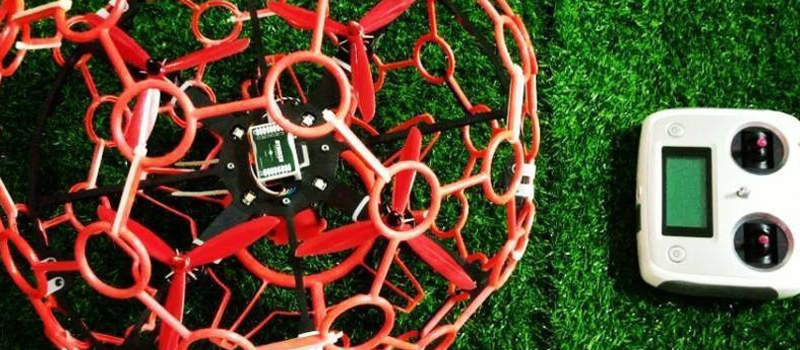Perhaps it’s innovation, or perhaps it’s just a product of boredom, but it seems that drones are finding their way into more inventive areas. A relatively unique and unusual way to use drones is drone soccer – a new competitive sport played with drones.
Not many people are familiar with drone soccer despite the sport existing to some degree within the last ten years. What exactly is drone soccer and how is it played? Will drone soccer ever achieve mainstream popularity in the same way that drone racing has?
The basics of drone soccer
Drone soccer is a game played by two teams, with each team composed of at least three players. Each player controls a drone that has been fitted with a protective anti-collision cage. Each team also has a goal that they need to defend.
The goal of the game is to have a drone fly towards and through the goal defended by the opposite team. Each team has a designated Striker whose task is to fly through the goal. The other two members will have to defend both their goal as well as the Striker. Each game consists of three sets lasting three minutes each. The team with the highest score at the end of the game wins.
Drone soccer was first played in South Korea back in 2018. The debut event for the sport was “The 2018 Robo Universe Drone Soccer” where 22 teams competed for the championship. That event was a lot more grandiose than what we see nowadays,
The standard rules of drone soccer require a total flying zone that measures 20 meters by 10 meters. This flying zone is surrounded by a net for the protection of the players and spectators.
What is its appeal?
Before drone soccer, the only competitive sport played using drones is racing. While an exciting sport on its own, drone racing requires exceptional drone flight skills. This has made drone racing quite intimidating to enter for beginners.
In contrast, the nature of drone soccer is a bit more welcoming, both to beginners and spectators. It has relatively simple rules and matches are quite short. Winning matches also does not come down to who has customized their drones better, as matches are played using standard drone models.
Despite its simplicity, drone soccer also requires substantial strategy and flight skills. This is a true team game where each player has a significant role to play.
A huge factor for the boom in popularity of drone soccer is that it can be set up easily. Unlike drone racing, drone soccer only needs a small area. With just a net and markers for the goals, drone soccer can be done in any standard school gymnasium or even in a classroom.
An official of US Drone Soccer has succinctly described it as “like Quidditch” but played with drones. That about sums up the potential of drone soccer to gain mainstream popularity.
Drone soccer can also be an avenue for drone pilots to learn about building and coding their own drones. Much like F1 cars, drones that are damaged during a match can be repaired to get them going again. STEM education through drone soccer is one of the primary goals of drone soccer groups being formed worldwide.
Potential for popularity
While drone racing has been around for more than a decade, it has remained a fairly niche sport due to a high barrier of entry both for players and spectators. Drone soccer dials back the complexity a fair bit, making it more palatable to the general audience.
South Korea, being the birthplace of drone soccer, seems heavily invested in the sport. According to a 2021 news report, the Korea Drone Football Association is building a drone soccer international center to prepare for the first drone soccer world cup in 2025. The 11-billion won funding for construction is being provided by the city of Jeonju.
In Europe, drone soccer was first put in the spotlight during the 2019 Amsterdam Drone Week. The introduction was made by Patrick Coumans of The Drone Racing Federation (DRF). Right now, the DRF sells the drones and other accessories needed to play drone soccer. They also provide assistance to schools that want to set up their own drone soccer teams and leagues.
In the US, regular drone soccer events are being held by Colorado-based US Drone Soccer. The group provides education and starter kits to schools and universities that wish to participate in the sport. They actively try to form partnerships with other organizations to establish physical venues for events and grow their membership.
Right now, the adoption of drone soccer in the US and Europe is just above the grassroots level of organization. The planned 2025 drone soccer world cup in Korea can be a huge milestone for this sport. If the event gets the media mileage it deserves, it may very well be the spark that ignites a global demand to play drone soccer.
Final Thoughts
It’s refreshing to see that drone technology has evolved and innovated beyond just commercial and industrial use. Yes, drones can be profitable, but drone soccer proves that they can also be used in other, more entertaining ways.
Hopefully, drone soccer can soon stand side-by-side with drone racing as a new way for people to experience drone flight. Putting drones in the hands of more people would be a great way to enhance the public perception of drone technology.



